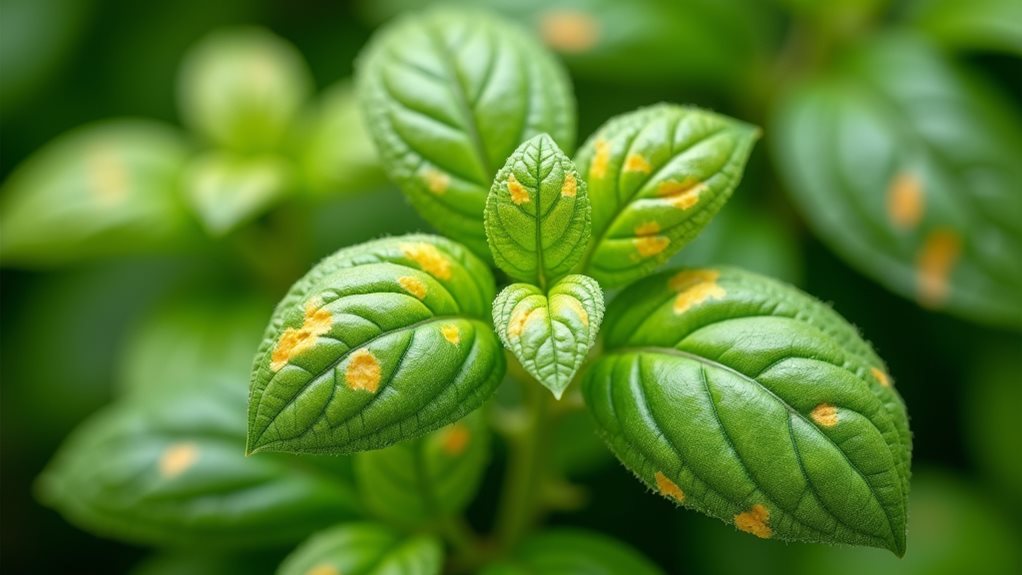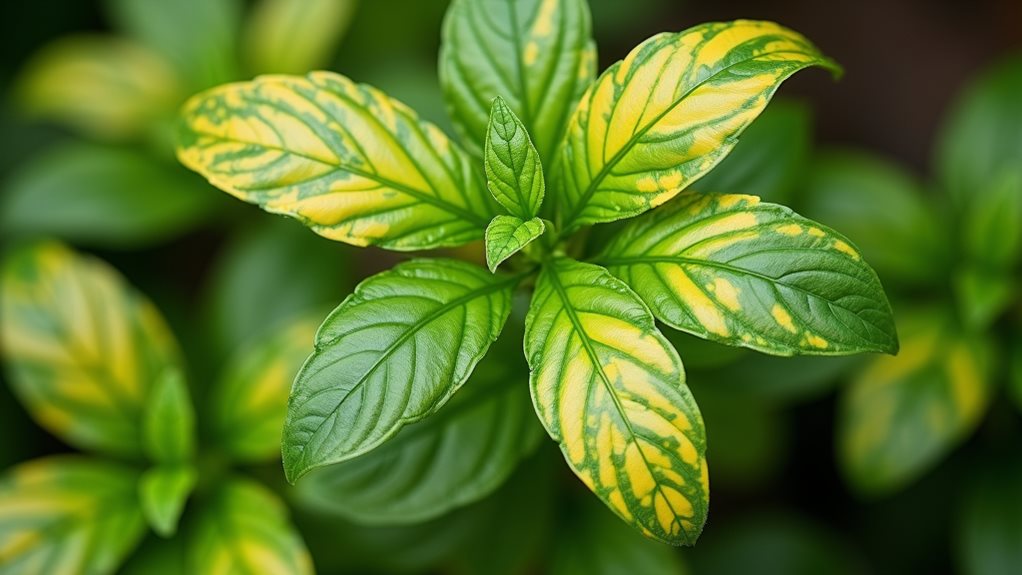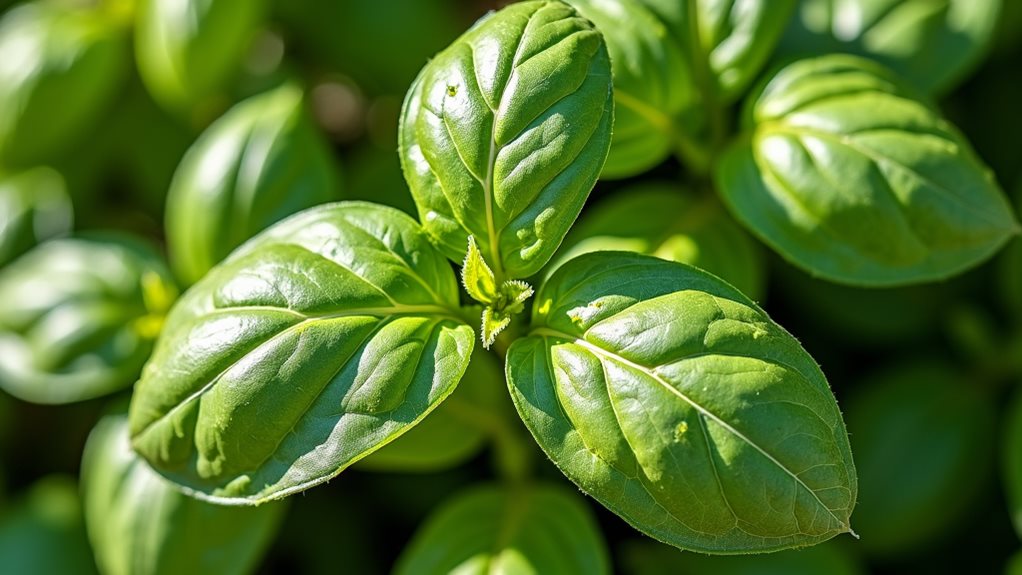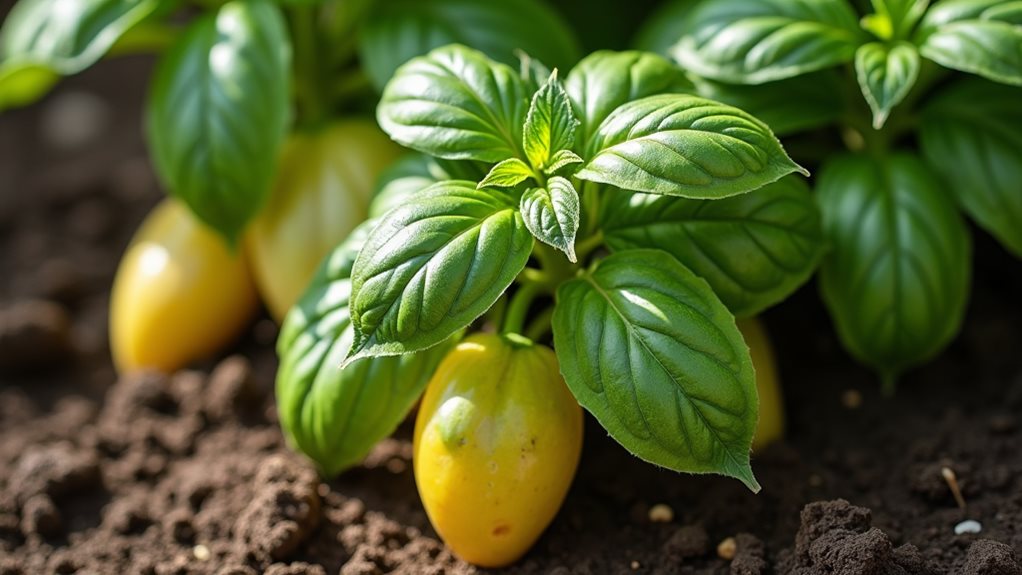Your basil's yellow leaves can stem from several common issues that you'll need to identify for proper treatment. The most frequent causes include improper watering (either too much or too little), insufficient sunlight exposure (less than 6-8 hours daily), or nutrient deficiencies, particularly in nitrogen, magnesium, or iron. Environmental stressors like temperatures below 50°F or above 80°F can also trigger yellowing, while pest infestations and fungal diseases such as downy mildew present additional concerns. Checking your plant's growing conditions, soil moisture, and leaf patterns will help pinpoint the specific problem and guide you toward the most effective solution.
TLDR
- Inadequate watering practices, either overwatering or underwatering, can cause basil leaves to turn yellow and affect nutrient absorption.
- Insufficient sunlight exposure, less than 6-8 hours daily, leads to yellowing leaves as basil requires direct sunlight to thrive.
- Nutrient deficiencies, particularly in nitrogen, iron, and magnesium, commonly result in yellowing leaves and stunted plant growth.
- Fungal diseases like downy mildew and fusarium wilt manifest through yellow foliage and gray fuzz underneath leaves.
- Temperature stress from cold exposure below 50°F or heat above 80°F can trigger yellowing and leaf deterioration.
Understanding Yellow Basil Leaves

On your basil plant, yellow leaves can signal several underlying problems that need your attention.
The discoloration you're seeing might stem from fungal diseases like downy mildew, pest infestations such as aphids, or environmental stressors including cold temperatures and insufficient light.
Understanding these potential causes is vital, as each requires different treatment approaches to restore your plant's health. For optimal growth, your basil should receive 6-8 hours of direct sunlight daily.
Watering and Drainage Problems
Water management sits at the heart of preventing yellow basil leaves, with both overwatering and underwatering posing significant risks to your plant's health.
When you overwater, roots become waterlogged and can't absorb nutrients properly, while underwatering causes leaves to droop and turn crispy. Checking your soil's moisture level with a finger test method is essential for determining whether your basil needs water. Additionally, ensuring your soil has well-draining properties can further help prevent waterlogged roots.
To maintain healthy basil, guarantee proper drainage through well-draining soil and pots with adequate holes.
Essential Nutrient Requirements

Your basil's yellowing leaves could point to deficiencies in essential nutrients, particularly nitrogen, magnesium, and iron, which are vital for maintaining lively green foliage. Additionally, poor soil quality can hinder nutrient absorption, further exacerbating the issue.
To identify specific nutrient deficiencies, you'll need to examine the pattern of yellowing, as nitrogen deficiency typically affects older leaves first, while iron deficiency usually appears in younger growth.
You can address these nutritional needs through a balanced NPK fertilizer application every 4-6 weeks during the growing season, making sure to follow package instructions for proper dosage. Since basil is a low-calorie herb, ensuring proper nutrients won't compromise its nutritional profile while maintaining healthy growth.
Primary Macronutrients For Basil
Plant nutrients play an essential role in keeping your basil healthy and preventing yellow leaves.
Four key macronutrients are particularly important:
- nitrogen promotes leaf growth and chlorophyll production;
- potassium supports overall health and nutrient transport;
- magnesium aids in essential oil production and photosynthesis;
- and calcium strengthens cell walls and facilitates root development.
If you're noticing yellowing, these nutrients may be deficient. Just like human bodies need specific amounts of daily calcium, basil requires proper nutrient levels to thrive and maintain its vibrant green color.
Signs Of Nutrient Deficiency
Several key nutrient deficiencies can cause basil leaves to turn yellow, each with distinct patterns and characteristics that help identify the specific problem.
When you notice yellowing between leaf veins on older leaves, it's likely magnesium deficiency, while similar patterns on young leaves suggest iron deficiency.
If you see brown, papery spots along leaf margins with yellowing, you're probably dealing with potassium deficiency.
Fertilizing Schedule And Methods
Once you've identified a nutrient deficiency, maintaining a proper fertilizing schedule can help prevent future yellowing issues.
You'll need to fertilize indoor basil every 4-6 weeks, while outdoor potted plants require feeding every 2-3 weeks.
Apply a balanced, water-soluble fertilizer at half strength, focusing on nitrogen-rich formulas to promote healthy leaf growth and essential oils production.
Always water thoroughly after application.
Lighting and Temperature Conditions
Proper lighting and temperature conditions play an essential role in maintaining healthy basil plants.
Your basil needs 6-8 hours of direct sunlight daily to prevent yellowing leaves, though partial shade can protect against leaf burn in hot climates.
You'll want to maintain temperatures between 50°F and 80°F, as cold shock below 50°F or heat stress above 80°F will cause yellowing and potential leaf drop.
Common Plant Diseases

Disease pathogens can quickly turn your lively basil plants from green to yellow.
The most common culprits include downy mildew, which causes yellowing between leaf veins with gray fuzz underneath; fusarium wilt, leading to yellowed shoots and stem discoloration; and bacterial leaf spot, creating water-soaked dark patches.
Leaf spot disease can also trigger yellowing through brown-to-black spots and defoliation. Additionally, cold temperatures can exacerbate stress on plants, making them more susceptible to diseases.
Pest Infestations
On the hunt for yellowing basil leaves, you'll often find tiny pests at work.
Aphids, spider mites, and caterpillars are common culprits, with each leaving distinct signs of damage. You'll spot aphids clustering under leaves, spider mites creating telltale webbing, and caterpillars leaving visible holes. Additionally, pests can weaken plants and make them more susceptible to toxic secretions, which may lead to further health issues.
If you're dealing with an infestation, try insecticidal soap, neem oil, or Bt, depending on the specific pest.
Growing Environment and Care

Creating the right growing environment for your basil requires careful attention to light placement, temperature control, and proper air circulation.
You'll want to position your basil where it receives 6-8 hours of direct sunlight daily, while maintaining temperatures between 65-85°F through seasonal adjustments and protection from cold drafts.
Ensuring good airflow around your plants, whether through proper spacing outdoors or using small fans indoors, helps prevent moisture-related issues and strengthens the stems while reducing the risk of fungal problems.
Light Requirements and Placement
Light plays an essential role in preventing basil leaves from turning yellow.
Your plant needs at least 6 hours of direct sunlight daily to thrive, with 6-8 hours being ideal.
If you're growing indoors, place your basil near a south-facing window, though you may need to supplement with grow lights positioned 6-12 inches above the plants for 12-14 hours daily.
Temperature Control Year-Round
Temperature control is essential for preventing yellow leaves and maintaining healthy basil plants. Your basil needs temperatures between 80-90°F during the day and shouldn't drop below 50°F at night, as cold conditions can trigger yellowing.
If you're growing indoors, keep temperatures between 65-70°F, and don't place your plants near drafty windows or air vents that could create cold spots.
Proper Ventilation Techniques
Proper ventilation plays an essential role in preventing yellow basil leaves and maintaining plant health.
You'll want to space your basil plants 12 to 18 inches apart outdoors, or 6 to 8 inches in containers, ensuring adequate airflow between them.
Remember to regularly prune crowded areas and remove affected leaves, as good air circulation helps prevent fungal diseases that can cause yellowing.
And Finally
If you're dealing with yellowing basil leaves, you'll need to assess multiple factors to restore your plant's health. Check your watering routine, guarantee proper drainage, verify nutrient levels, and examine growing conditions including light exposure and temperature. Don't forget to inspect for signs of disease or pest problems. With careful observation and appropriate adjustments to care, you can maintain healthy, colorful basil plants that thrive year-round.